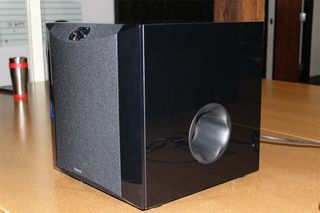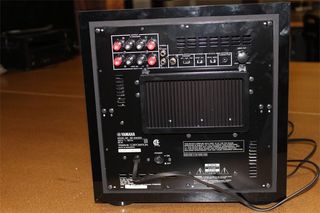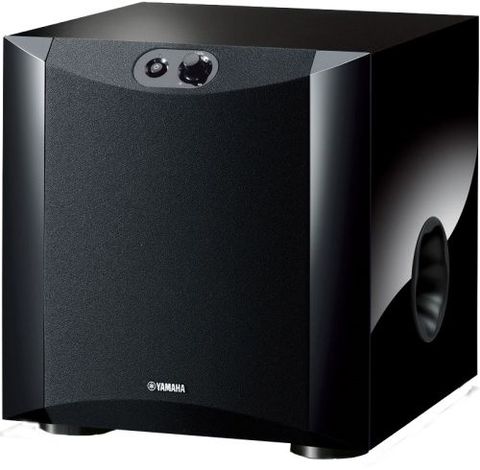The Yamaha NS-SW300 sounded great in every phase of our testing. This 10-inch home subwoofer has the lowest low-frequency rating in our test group, which helps it compete with larger, more powerful 12-inch woofers. Its smart design features, like front-panel power and volume controls and a side-ported cabinet, make it easy to find a good place to put it and to adjust the settings to suit the type of content you’re playing. We awarded the Yamaha NS-SW300 our Top Ten Reviews Gold Award because it combines great features with even better sound.

To test the limits of powered subwoofers, we watched action movie scenes and listened to a variety of recorded and live music. For the movie portion of our test, we watched action scenes from two movies: the James Bond movie “Skyfall” and “Rogue One: A Star Wars Story.”
This Yamaha subwoofer scored well in both tests, but it performed particularly well in the short action scene one – in fact, it received higher scores than every other subwoofer in this assessment. Toward the end of “Rogue One: A Star Wars Story,” there is a scene that has an abundance of short-bursting low-frequency effects. The NS-SW300 projected them as clear, concise bursts that made it seem like the blaster fire was surrounding our listening area.
The scene we watched from “Skyfall” tests the subwoofers’ lowest limits with a 15-second long, sustained rumbling effect, and it showed amplification and frequency separation flaws in more than half of our test group. During this scene, the sub showed no signs of volume loss or port noise, and there weren’t any frequency separation flaws.
The Yamaha NS-SW300 also received the highest scores in our acoustic music listening test. The highly efficient 10-inch woofer projected a natural and smooth low-end that played the perfect supporting role to our floor standing speakers. If you listen to music through your home audio system, you don’t want the subwoofer to be the star of the show – this one injected just the right amount of bass during the test and would pair well with full-range speakers of any size.
This subwoofer has the widest frequency range of all the 10-inch speakers we tested. It starts at 20Hz on the low end, which is the lowest threshold of human hearing, and goes up to 160Hz on the high end. A 20Hz low-frequency response is impressive for a subwoofer in this price range, especially a 10-inch one. Our tests proved that this subwoofer can project long and low musical notes and movie effects accurately and at a volume that sounds natural and unobtrusive.

Yamaha does not advertise a peak power rating on the NS-SW300, nor could the helpful customer support representative tell us one. That’s ok because we don’t pay much attention to peak power ratings – they are mostly for marketing and don’t actually say much about the speaker’s performance. Instead, we look at the continuous power rating, which says, on average, how much amplification is being sent to the speaker. This Yamaha subwoofer delivers 250-watts of continuous power, which makes it the most powerful 10-inch subwoofer we tested.
During our movie and music listening tests, we volume matched all the subwoofers to 85 decibels (dB), which is about as loud as a commercial theater. We only needed to turn the NS-SW300’s volume knob up to 50 to 60 percent of its total capacity to hit that mark. Most of the other 10-inch woofers we tested needed to be turned up to between 80 and 90 percent to reach the same volume. That means this subwoofer works half as hard as its competitors, which typically extends the life of the amplifier.

The Yamaha NS-SW300 has some unique design features that make it easy to set up and adjust. The front panel houses a power button and a volume knob, which means it is the only subwoofer we tested that doesn’t require you to reach around to the back to turn it on or adjust its volume. This seems like an insignificant design feature, but if you listen to a variety of content through your home audio system, being able to quickly adjust the volume comes in handy.
The back panel has all the connection options we look for on a home subwoofer. It has an LFE input that accepts a crossed-over signal from an AV receiver as well as stereo RCA inputs if your AV receiver has a normal subwoofer output. It also has speaker-level inputs and outputs, so you can use it with an older two-channel stereo receiver.
If your AV receiver doesn’t have an LFE output, the Yamaha SW300 has a variable crossover on the back panel that allows you to adjust the low-frequency starting point from 40Hz to 140Hz. We suggest starting the crossover at 80Hz and working up from there.
One minor annoyance of having the power button and volume knob on the front panel is that you can’t remove the grille cloth. The grille cloth doesn’t affect sound as much, if at all, with a subwoofer as it does with full-range speakers, but watching the speaker move during loud and booming actions scenes can add aesthetic value to your home theater room.
This is the only subwoofer we tested that has a side-firing port. The unique Twisted Flare port design is specific to Yamaha subwoofers, and the company claims its cyclonic shape moves air more efficiently out of the enclosure, resulting in louder and more accurate bass.
The sub’s MDF cabinet as a high-gloss finish, which looks great when it’s clean but isn’t forgiving with fingerprints and dust.
Yamaha only covers this subwoofer for two years against defects and workmanship. That is below average for a home subwoofer of this price. You can reach the manufacturer by phone or email if you have questions about the setup process. We found the support staff to be knowledgeable about the products, although it took almost two full days to receive an email response.
The Yamaha NS-SW300 isn’t the cheapest subwoofer we tested, but the sound and design features make it well worth the extra $100 to $200. It supported our floor standing speakers without overpowering them, which is what you want from a speaker that is made to only deliver the lowest frequencies. This subwoofer fits nicely in any size room and can complement any size full-range speaker system.


